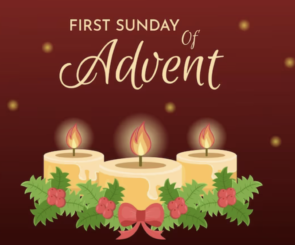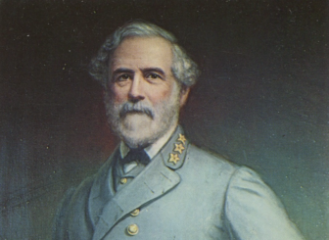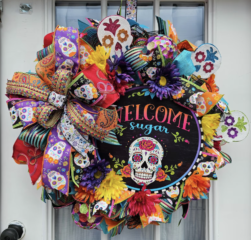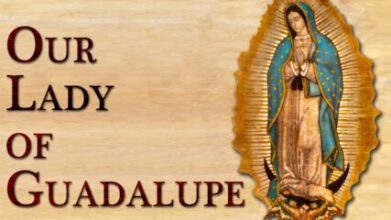The First Sunday of Advent marks the beginning of the liturgical year in many Christian traditions, including the Roman Catholic, Anglican, and Lutheran churches. It falls on the ‘fourth Sunday before Christmas’, signaling the start of the Advent season, a period of anticipation and preparation for the celebration of the birth of Jesus Christ. During this time, churches and homes are often adorned with Advent wreaths, with one candle being lit on each of the four Sundays leading up to Christmas. The First Sunday of Advent serves as a time of reflection and hope, as Christians embark on a spiritual journey that ultimately culminates in the joyous celebration of Christmas.
In Year 2023, The First Sunday of Advent is on 3 December. Type: Religious Christian Holiday
Origin of First Sunday of Advent
The exact origins of the First Sunday of Advent are unknown. Some scholars believe that it began in the fifth century, when Bishop Perpetuus of Tours established a fast from St. Martin’s Day (November 11) to Christmas. This fast was known as “Lent of St. Martin” or “Nativity Fast.”
Other scholars believe that Advent may have originated earlier, perhaps in the fourth century. They point to the fact that there is evidence of a pre-Advent fast in Spain and Gaul during this time.
Regardless of its exact origins, Advent became firmly established as a season of preparation for Christmas in the early Middle Ages. The First Sunday of Advent marked the beginning of this season, and it was a time for Christians to reflect on the coming of Christ, both in His first coming as a baby and in His second coming as judge.
The Advent Season: A Time of Preparation
In the centuries since its inception, the First Sunday of Advent has taken on a number of different meanings and traditions. For example, in many churches, the first Advent candle is lit on this day, representing the hope of the coming of Christ.
Advent, which means “coming” or “arrival,” is a season observed in various Christian denominations, including Catholic, Protestant, and Orthodox churches. It encompasses the four Sundays leading up to Christmas and serves as a period of preparation, reflection, and anticipation. The First Sunday of Advent marks the official start of this spiritual journey.
Advent Wreaths
One of the most recognizable symbols of the Advent season is the Advent wreath. Typically, it consists of a circular wreath with four candles—three purple or blue and one pink, often surrounded by evergreen branches. The candles represent different aspects of the Advent story, with the first candle symbolizing hope.
Lighting the Candle of Hope
On the First Sunday of Advent, the ‘first candle is lit’ in many households and churches. This candle represents hope, symbolizing the anticipation of the coming of Christ, who is seen as the “Light of the World.”
Biblical Readings and Themes
The Advent season is marked by a set of biblical readings and themes that focus on hope, peace, joy, and love. Each Sunday of Advent is dedicated to a specific theme, with hope taking center stage on the First Sunday.
1.Hope: First Sunday Theme
The readings for this day focus on the Old Testament patriarchs, who were Christ’s ancestors. These patriarchs were people of faith who looked forward to the coming of the Messiah. Their story gives hope that Christ will come again and that people will be saved.
2.Preparing the way: Second Sunday Theme
The readings also speak of the prophets who prepared the way for Christ’s coming. They called the people to repentance and to turn to God. We are called to follow their example and to prepare the way for Christ’s return in our own lives.
2. Waiting: Third Sunday Theme
The First Sunday of Advent is a time to wait expectantly for the coming of Christ. We wait for Him to come again in glory, to judge the living and the dead. We also wait for Him to come into our hearts and to transform our lives.
Counting Down to Christmas
Advent calendars are another cherished tradition, often used by children and families to count down the days until Christmas. These calendars often include small treats, verses, or religious images behind each numbered window, reinforcing the sense of anticipation.
The First Sunday of Advent in American Tradition
The First Sunday of Advent in the United States carries with it a sense of unity and anticipation, with millions of American Christians participating in various religious customs and practices.
Church Services
On this day, many churches hold special services or Masses to mark the start of Advent. During these services, the Advent wreath is often prominently displayed, and the first candle is lit.
Family Gatherings
Families come together to light the first Advent candle in their homes, sharing the significance of the season with children and loved ones.
Acts of Charity
Advent is a time of giving and goodwill, with many Americans engaging in acts of charity and kindness. It’s a season when people often donate to food banks, volunteer their time, or take part in programs to help those in need.
Community Events
Communities across the country host various events and gatherings to celebrate the Advent season. These may include Christmas markets, choral performances, and festivals that bring people together.
Things to do on The First Sunday of Advent
- Attend Church Services: Many Christians attend a church service on the First Sunday of Advent. During the service, special Advent prayers and scriptures are read, and the first candle on the Advent wreath is typically lit. The liturgy may focus on themes of hope and expectation.
- Light the First Candle: If you have an Advent wreath at home, light the first candle, known as the “Hope” or “Prophet’s Candle.” This candle represents the anticipation of Christ’s coming and the hope He brings to the world.
- Read Advent Devotions: Advent devotionals and readings are an excellent way to focus on the meaning of the season. Many families and individuals set aside time to read Advent-themed passages from the Bible and reflect on their significance.
- Advent Calendar: Some people use Advent calendars, which have a small door to open for each day leading up to Christmas. Each day reveals a scripture, a short message, or a small treat, helping to build anticipation.
- Spend Time in Prayer: The Advent season is a time of spiritual reflection and preparation. Consider setting aside moments for prayer and meditation, focusing on the themes of hope and expectation.
- Acts of Kindness: Advent is also a time for acts of kindness and charity. You can engage in activities such as donating to charity, volunteering, or performing random acts of kindness for others.
- Decorations: Decorate your home with Advent symbols, such as the Advent wreath and purple or blue decorations, which are traditional Advent colors. These colors symbolize penance, preparation, and royalty.
- Advent Hymns and Music: Listen to or sing Advent hymns and carols. These often focus on the anticipation of Christ’s arrival.
- Create an Advent Calendar: Make or buy an Advent calendar to help count down the days to Christmas. It can be a fun and interactive way to engage children in the season.
- Educational Activities: Use this time to learn about the history and significance of Advent and its traditions, especially if you have children. You can engage in educational activities and discussions about the season.
The First Sunday of Advent in Pop Culture
The First Sunday of Advent is not a major holiday in pop culture, but it has been referenced in a few films and television shows.
- In the 2003 film Elf, Buddy the Elf visits a department store on the First Sunday of Advent and is amazed by the Christmas decorations.
- In the 2004 television show Scrubs, J.D. and Turk argue about whether or not it is acceptable to put up Christmas decorations before the First Sunday of Advent.
- In the 2018 television show The Good Place, Eleanor Shellstrop is surprised to learn that there is a Christian holiday called Advent.
The First Sunday of Advent is also referenced in some Christmas songs. For example, the song “The First Noel” mentions the fact that the shepherds were watching their flocks on the First Sunday of Advent when they saw the angel Gabriel.
Overall, the First Sunday of Advent is not a major focus of pop culture, but it has been referenced in a few films, television shows, and songs.
Here are some other examples of pop culture references to the First Sunday of Advent:
- In the 1994 film Miracle on 34th Street, the Macy’s Thanksgiving Day Parade floats include a representation of the First Sunday of Advent.
- In the 2011 film Arthur Christmas, Santa Claus’s elves are preparing for the First Sunday of Advent by decorating the North Pole with Advent wreaths and candles.
- In the 2019 film Klaus, the children of Smeerensburg are excited to celebrate the First Sunday of Advent with a special Advent calendar.
These references to the First Sunday of Advent in pop culture help to remind us of the importance of this season of preparation for Christmas.
The First Sunday of Advent in the USA is a significant occasion that launches a season of reflection, hope, and anticipation. It serves as a reminder of the true meaning of Christmas—a time for spiritual growth, love, and giving. As families, churches, and communities come together to celebrate this season, the First Sunday of Advent offers a time of unity, preparation, and the shared anticipation of the birth of Christ, whose light continues to shine brightly in the hearts of many Americans.
FAQs
Q1. What is the First Sunday of Advent?
The First Sunday of Advent is the first day of the liturgical season of Advent in many Christian traditions. It marks the beginning of the church’s preparation for the celebration of the birth of Jesus Christ.
Q2. When does the First Sunday of Advent occur?
The First Sunday of Advent falls on the fourth Sunday before Christmas. It varies each year but typically falls between November 27th and December 3rd.
Q3. What is the significance of the First Sunday of Advent?
The First Sunday of Advent is significant as it initiates a period of anticipation, hope, and spiritual preparation for the coming of Christ. It symbolizes the beginning of the Advent season.
Q4. Why is the First Sunday of Advent called “Advent”?
The word “Advent” is derived from the Latin word “adventus,” meaning “coming” or “arrival.” It refers to the anticipation of the coming of Christ, both in his historical birth and his future return.
Q5. What is the Advent wreath, and how is it used on the First Sunday of Advent?
The Advent wreath is a circular wreath with four candles, typically three purple or blue candles and one pink or rose candle. On the First Sunday of Advent, the first candle is lit, symbolizing hope. Each subsequent candle is lit on the following Sundays, representing different themes such as peace, joy, and love.
Q6. What are some common liturgical colors associated with the First Sunday of Advent?
The liturgical colors for Advent are typically purple or blue, which symbolize penance, preparation, and royalty. Some traditions use a pink or rose candle to symbolize joy on the third Sunday of Advent.
Q7. Do all Christian denominations celebrate the First Sunday of Advent?
The First Sunday of Advent is most commonly celebrated in Roman Catholic, Anglican, Lutheran, and many other liturgical Christian traditions. However, its observance and specific customs may vary among denominations.
Q8. How can individuals celebrate the First Sunday of Advent at home?
Individuals can celebrate the First Sunday of Advent by attending church services, lighting the first candle on an Advent wreath, engaging in Advent readings and prayers, and participating in acts of charity and kindness. It’s also an excellent time for personal reflection and meditation.
Q9. Are there any specific Bible readings associated with the First Sunday of Advent?
A. There are various Bible readings and passages associated with the First Sunday of Advent, including selections from the Old Testament prophesying the coming of the Messiah and passages from the New Testament that focus on hope and expectation. The specific readings may vary depending on the liturgical calendar used by the church.
Q10. How long does the Advent season last, and when does it end?
A. The Advent season typically lasts for four weeks, leading up to Christmas Day, which is celebrated on December 25th. The Advent season officially concludes at the start of Christmas Eve.




